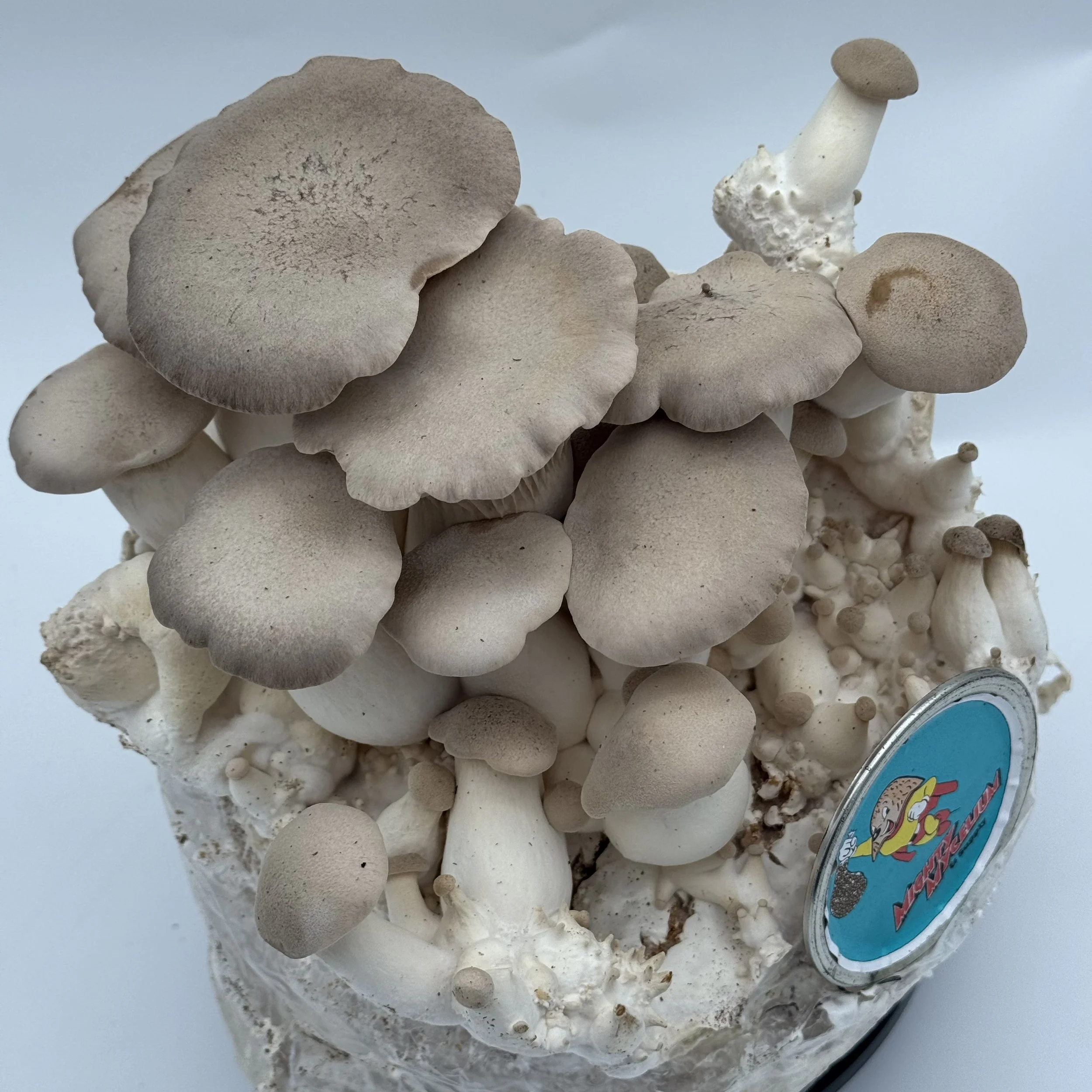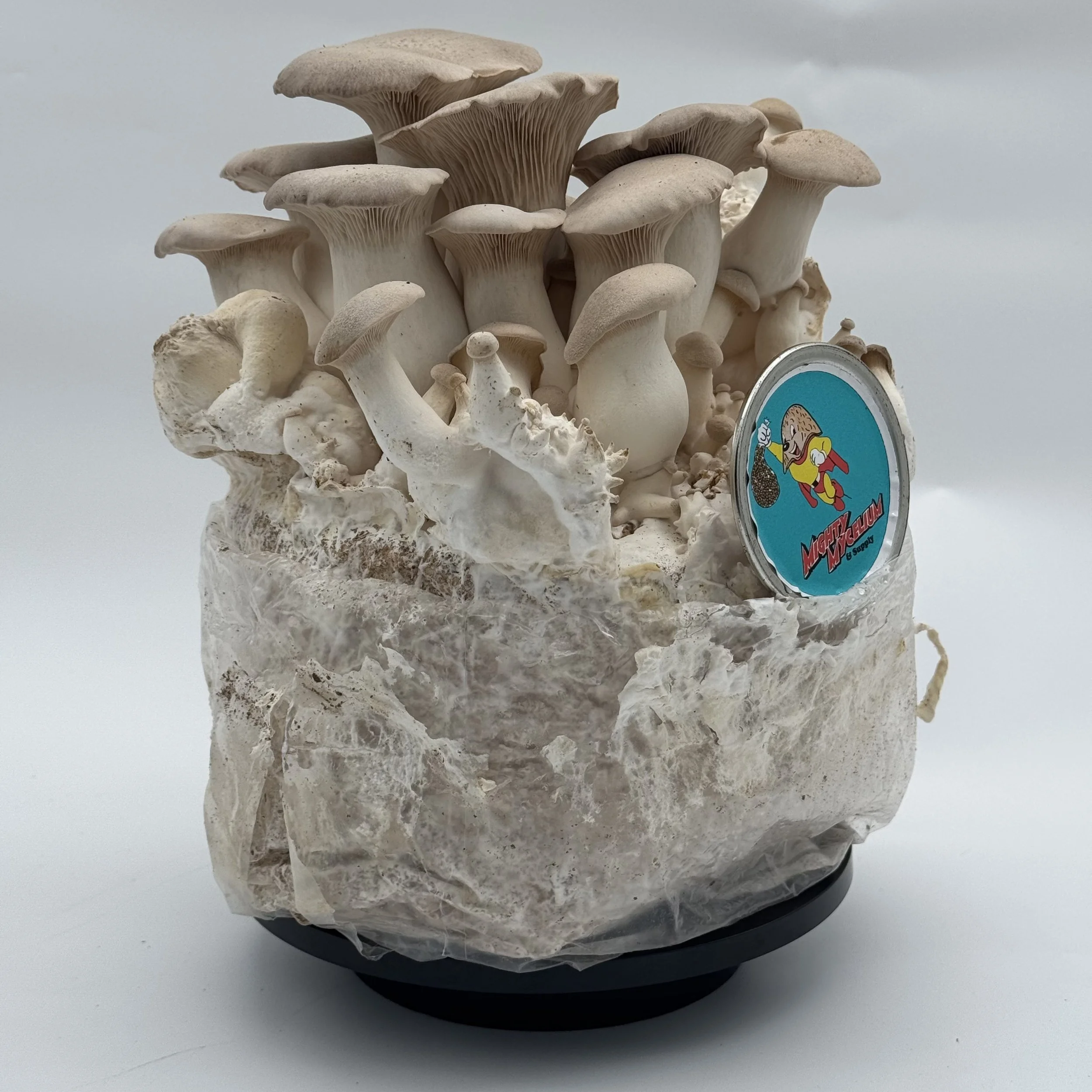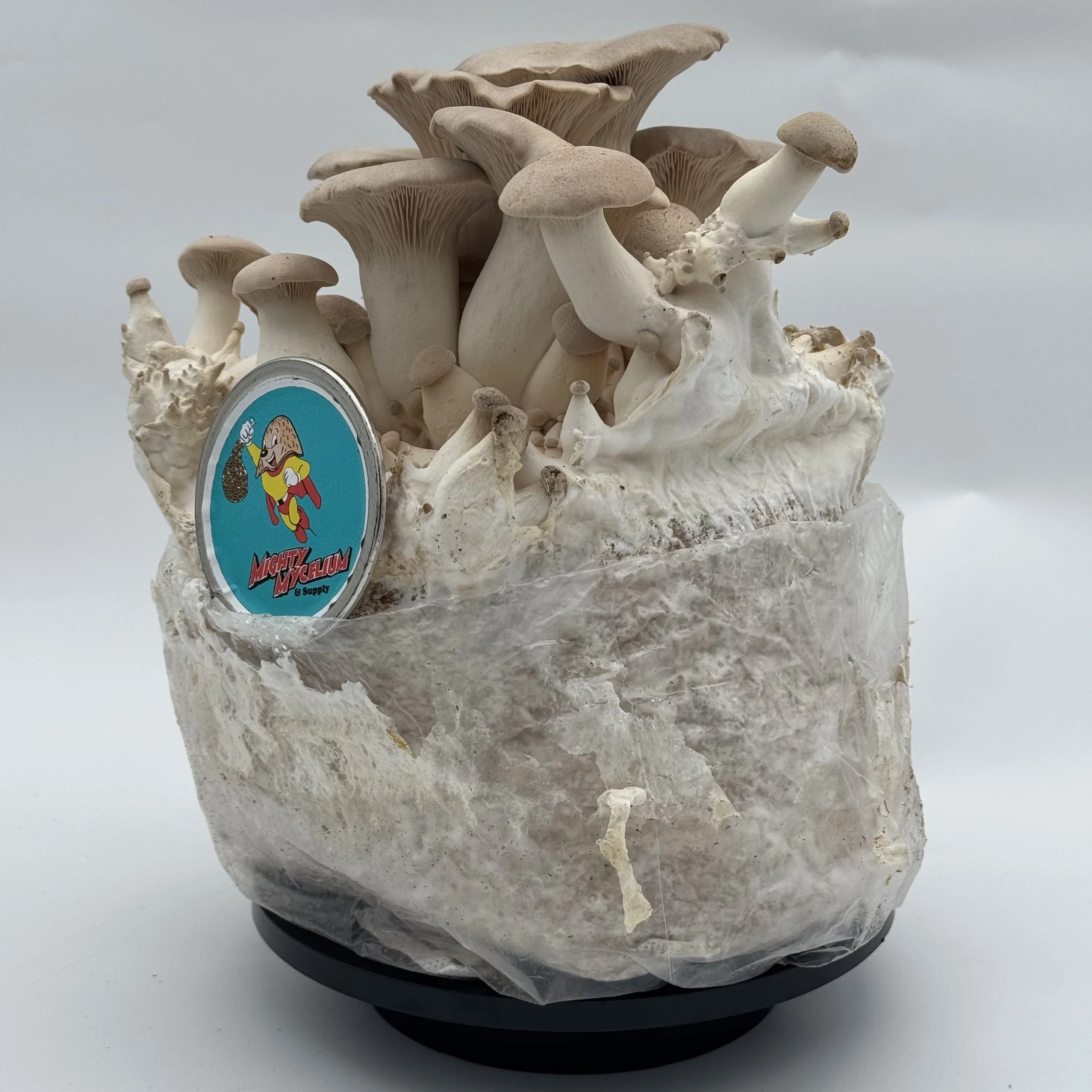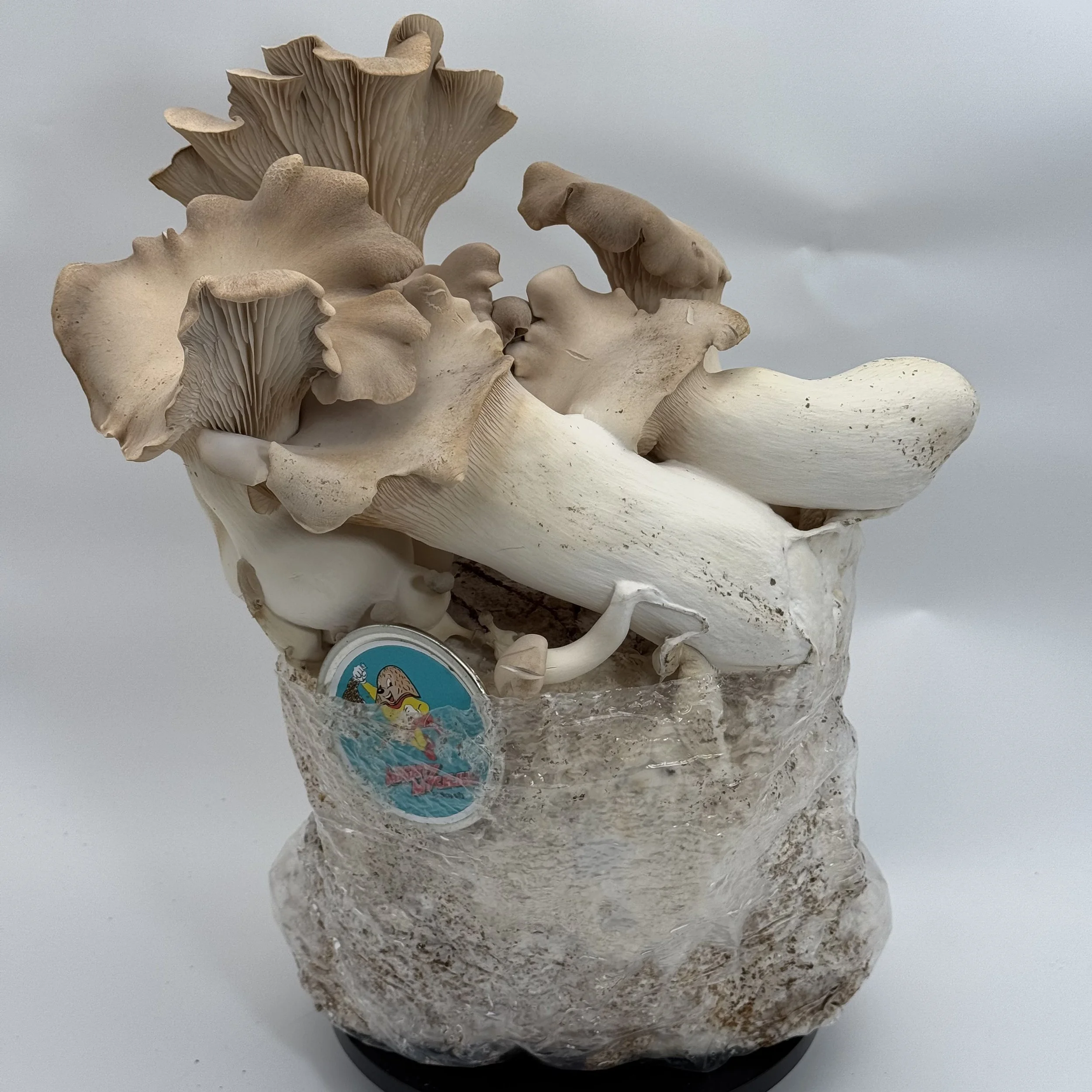 Image 1 of 13
Image 1 of 13

 Image 2 of 13
Image 2 of 13

 Image 3 of 13
Image 3 of 13

 Image 4 of 13
Image 4 of 13

 Image 5 of 13
Image 5 of 13

 Image 6 of 13
Image 6 of 13

 Image 7 of 13
Image 7 of 13

 Image 8 of 13
Image 8 of 13

 Image 9 of 13
Image 9 of 13

 Image 10 of 13
Image 10 of 13

 Image 11 of 13
Image 11 of 13

 Image 12 of 13
Image 12 of 13

 Image 13 of 13
Image 13 of 13














King Oyster Mushroom (Pleurotus Eryngii) Long Term Storage Slant/ Vial & Agar Plate
🍄 King Oyster Mushroom Overview
Common Name: King Oyster Mushroom
Scientific Name: Pleurotus eryngii
Other Names: King Trumpet Mushroom, French Horn Mushroom, Trumpet Royale
Native Range: Mediterranean, Middle East, North Africa, and Central Asia
🔬 Taxonomy of King Oyster Mushroom
RankClassificationDomainEukaryotaKingdomFungiPhylumBasidiomycotaClassAgaricomycetesOrderAgaricalesFamilyPleurotaceaeGenusPleurotusSpeciesPleurotus eryngiiAuthority(DC.) Quél. (1872)
🧬 Biological and Morphological Characteristics
FeatureDescriptionCap5–15 cm, convex to flat, tan to light brownStem (stipe)Thick, white, firm, meaty; often the largest partGillsDecurrent (run down the stem), white to creamSpore PrintWhiteTextureDense, chewy, and meatyFlavorMild umami, can resemble abalone or scallops when cooked
Ecological Type: Saprotrophic (decomposes dead organic matter)
Substrate: Commonly found growing on the roots of herbaceous plants (especially umbellifers like Eryngium – hence the species name).
🌍 Habitat and Distribution
Naturally occurs in the Mediterranean, Central Asia, and parts of Europe and North Africa.
Grows in semi-arid to temperate environments, often in grasslands or disturbed areas.
Rarely found in the wild; mostly cultivated commercially due to its slow natural growth.
🌾 Cultivation
⚙️ Commercial Cultivation
Substrate: Straw, sawdust, corncobs, cottonseed hulls, enriched with bran
Conditions:
Temperature: 18–24°C (65–75°F)
Humidity: 85–95%
CO₂ control is critical—high CO₂ encourages thicker stems
Growth Cycle: 4–6 weeks from inoculation to harvest
Yield: High yield and long shelf life
🍽️ Why It's Popular:
Large, uniform fruiting bodies
Long shelf-life (compared to P. ostreatus)
Meaty texture ideal for plant-based dishes
🍳 Culinary Uses
Texture: Dense, chewy—similar to seafood or meat
Popular in: East Asian cuisine, especially Korean, Japanese, and Chinese dishes
Cooking Methods:
Grilled or roasted (sliced lengthwise like scallops or steaks)
Stir-fried or sautéed
Used in soups, hot pots, or vegan "pulled pork"
Absorbs flavors well, especially soy sauce, garlic, miso, and vinegar
⚕️ Medicinal and Nutritional Benefits
Nutrient / CompoundBenefitsBeta-glucansImmune modulation, anti-inflammatoryErgothioneineAntioxidant, anti-aging propertiesLovastatin-like compoundsMay help lower cholesterolProtein and FiberSupports satiety and gut healthB vitamins (B1, B2, B3, B5)Energy metabolismPotassium, PhosphorusHeart and bone health
📚 Studies suggest:
Antioxidant properties
Anti-tumor effects (in vitro)
Antimicrobial activity
Cholesterol-lowering potential
✅ Note: These benefits are promising but require more human clinical studies.
🔁 Comparison with Other Oyster Mushrooms
FeatureP. eryngii (King)P. ostreatus (Common Oyster)P. pulmonarius (Phoenix)Cap sizeLargeMediumSmallerStemVery thickThin to mediumThinTextureMeatySoftSoftShelf lifeLong (weeks)Short (days)ShortFlavorMild, savoryDelicateMild
📜 Etymology & Naming
"Pleurotus": Greek pleura = "side" + otos = "ear" (refers to side-growing, ear-shaped caps)
"eryngii": From Eryngium, the sea holly plant family, where it is sometimes found growing wild
🌱 Varieties and Strains
There are multiple cultivated strains of P. eryngii, selected for:
Cap-to-stem ratio
Growth speed
Resistance to disease
Adaptation to various climates
Some producers market "mini" or "baby king oyster" as specialty products, though they are often genetically identical to the standard strain—just harvested early.
📦 Storage and Shelf Life
Fresh: Can last 1–2 weeks refrigerated in a paper bag
Dried: Rehydrates well; shelf stable for months
Frozen: Can be cooked and frozen, but texture may degrade slightly
🚫 Toxicity and Safety
Pleurotus eryngii is edible and non-toxic.
No known poisonous look-alikes in commerce.
Wild identification should be careful, though confusion with toxic Omphalotus (Jack-o'-lantern mushrooms) is unlikely due to major morphological differences.
🍄 King Oyster Mushroom Overview
Common Name: King Oyster Mushroom
Scientific Name: Pleurotus eryngii
Other Names: King Trumpet Mushroom, French Horn Mushroom, Trumpet Royale
Native Range: Mediterranean, Middle East, North Africa, and Central Asia
🔬 Taxonomy of King Oyster Mushroom
RankClassificationDomainEukaryotaKingdomFungiPhylumBasidiomycotaClassAgaricomycetesOrderAgaricalesFamilyPleurotaceaeGenusPleurotusSpeciesPleurotus eryngiiAuthority(DC.) Quél. (1872)
🧬 Biological and Morphological Characteristics
FeatureDescriptionCap5–15 cm, convex to flat, tan to light brownStem (stipe)Thick, white, firm, meaty; often the largest partGillsDecurrent (run down the stem), white to creamSpore PrintWhiteTextureDense, chewy, and meatyFlavorMild umami, can resemble abalone or scallops when cooked
Ecological Type: Saprotrophic (decomposes dead organic matter)
Substrate: Commonly found growing on the roots of herbaceous plants (especially umbellifers like Eryngium – hence the species name).
🌍 Habitat and Distribution
Naturally occurs in the Mediterranean, Central Asia, and parts of Europe and North Africa.
Grows in semi-arid to temperate environments, often in grasslands or disturbed areas.
Rarely found in the wild; mostly cultivated commercially due to its slow natural growth.
🌾 Cultivation
⚙️ Commercial Cultivation
Substrate: Straw, sawdust, corncobs, cottonseed hulls, enriched with bran
Conditions:
Temperature: 18–24°C (65–75°F)
Humidity: 85–95%
CO₂ control is critical—high CO₂ encourages thicker stems
Growth Cycle: 4–6 weeks from inoculation to harvest
Yield: High yield and long shelf life
🍽️ Why It's Popular:
Large, uniform fruiting bodies
Long shelf-life (compared to P. ostreatus)
Meaty texture ideal for plant-based dishes
🍳 Culinary Uses
Texture: Dense, chewy—similar to seafood or meat
Popular in: East Asian cuisine, especially Korean, Japanese, and Chinese dishes
Cooking Methods:
Grilled or roasted (sliced lengthwise like scallops or steaks)
Stir-fried or sautéed
Used in soups, hot pots, or vegan "pulled pork"
Absorbs flavors well, especially soy sauce, garlic, miso, and vinegar
⚕️ Medicinal and Nutritional Benefits
Nutrient / CompoundBenefitsBeta-glucansImmune modulation, anti-inflammatoryErgothioneineAntioxidant, anti-aging propertiesLovastatin-like compoundsMay help lower cholesterolProtein and FiberSupports satiety and gut healthB vitamins (B1, B2, B3, B5)Energy metabolismPotassium, PhosphorusHeart and bone health
📚 Studies suggest:
Antioxidant properties
Anti-tumor effects (in vitro)
Antimicrobial activity
Cholesterol-lowering potential
✅ Note: These benefits are promising but require more human clinical studies.
🔁 Comparison with Other Oyster Mushrooms
FeatureP. eryngii (King)P. ostreatus (Common Oyster)P. pulmonarius (Phoenix)Cap sizeLargeMediumSmallerStemVery thickThin to mediumThinTextureMeatySoftSoftShelf lifeLong (weeks)Short (days)ShortFlavorMild, savoryDelicateMild
📜 Etymology & Naming
"Pleurotus": Greek pleura = "side" + otos = "ear" (refers to side-growing, ear-shaped caps)
"eryngii": From Eryngium, the sea holly plant family, where it is sometimes found growing wild
🌱 Varieties and Strains
There are multiple cultivated strains of P. eryngii, selected for:
Cap-to-stem ratio
Growth speed
Resistance to disease
Adaptation to various climates
Some producers market "mini" or "baby king oyster" as specialty products, though they are often genetically identical to the standard strain—just harvested early.
📦 Storage and Shelf Life
Fresh: Can last 1–2 weeks refrigerated in a paper bag
Dried: Rehydrates well; shelf stable for months
Frozen: Can be cooked and frozen, but texture may degrade slightly
🚫 Toxicity and Safety
Pleurotus eryngii is edible and non-toxic.
No known poisonous look-alikes in commerce.
Wild identification should be careful, though confusion with toxic Omphalotus (Jack-o'-lantern mushrooms) is unlikely due to major morphological differences.

